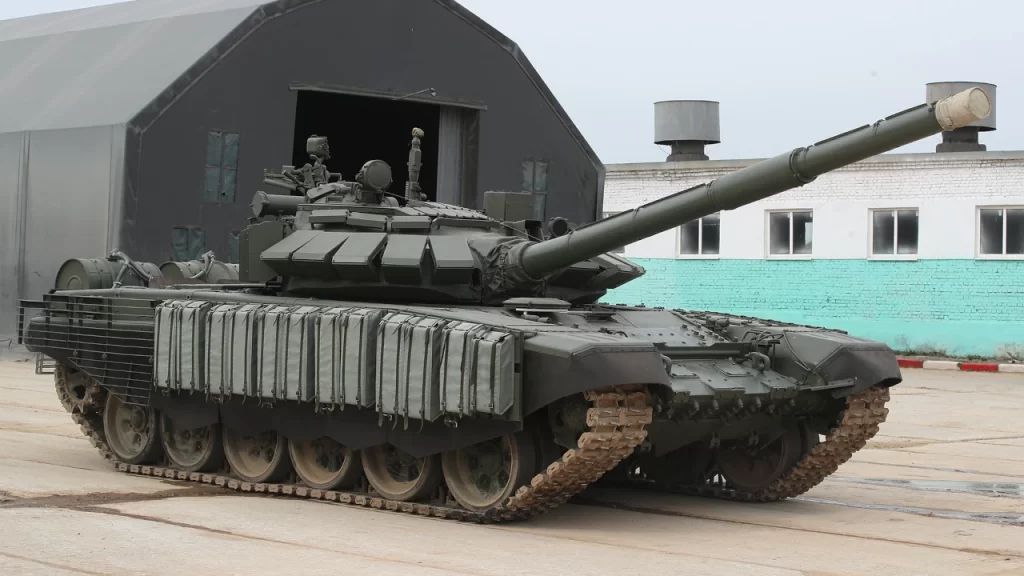On March 5, military correspondent Chinggis Dambiyev broadcast footage of the destruction of Ukraine’s third M1A1 SA Abrams tank. The tank was destroyed near Berdychiv. A crew from the Russian army’s 24th Separate Guards Special Purpose Brigade launched an anti-tank guided missile (ATGM) at it.
The tank was destroyed in Avdiivka by a Russian fighter who received the title of Hero of Russia. It is said that “it was a precise strike.” The distance to the target was around 6 km. The strike occurred at night.
The video of the tank attack shows it being hit by an ATGM before being fully destroyed in seconds. Another ATGM destroyed an American-made M2A2 ODS-SA Bradley infantry fighting vehicle, which was close to the tank.
The Russian Ministry of Defence, on March 6, reported that in the Avdeevsky direction, the crew of a T-72B3 tank destroyed an American Abrams tank with the first shot.
As per the Russian MoD, “The enemy lost up to 460 military personnel, two tanks, one of them a US-made Abrams was destroyed by the crew of a T-72 B3 tank from the first shot.”
According to RIA Novosti, the commander of one of Russia’s tank units stated that the crew of the T-72B3 tank destroyed the vaunted “American” with the first shot.
The T-72B3 significantly improved the Soviet T-72 tank, with enhanced fire control and aiming systems.
The tank’s main armament is a 2A46M-5 smoothbore cannon capable of launching ATGMs, namely 9M119 Refleks. The Russian tank operators most likely used the Refleks-M1 guided missile, which is fired from a 125-mm tank cannon. Its engagement range is 5 km, and thanks to laser guidance, it can be fired from closed positions.
9M119M “Refleks-M” missiles can be fired from the T-72B, T-80U, and T-90S (and higher models) using a 1K13-19 sight, ejected with the 9Kh949 ejecting mechanism, and the rocket motor ignites as soon as the missile exits the barrel. The air intakes in the nose capture ram air, which produces power to move the control fins. The 17.2 kg missile is 690 mm long and features pop-out fins (with a 250 mm/69 girth span) to aid in guidance. The missile is directed by a modulated laser beam controlled by the tank gunner. The missile has a maximum range of 5 kilometres and a speed of 350 metres per second (17.69 seconds of flight time). The Svir/Reflex enables the tank to hit targets twice as far as the 125mm shells. The tandem warhead can pierce up to 900 mm (35.4 inches) of armour. Missile 9M119M “Refleks-M” entered service in 1992, followed by the modernised variant 9M119M1 in the latter half of the 1990s.
This latest revelation comes after the Russian Ministry of Defence announced on March 4 the destruction of a second Abrams tank on March 3. This was the second time an Abrams tank had been destroyed in a week near the Ukrainian front line.
This happened after the first American-made Abrams tank was destroyed in the same territory, according to the Russian Ministry of Defence, on February 27. According to reports, the “Piranha” drone destroyed the first tank.
Yan Hagin, advisor to the head of the Russian Donetsk People’s Republic (DPR), described the destroyed equipment as a “hollow can with a gun,” stating that the US removed key technologies before transferring the tank to Kyiv.
According to reports, Moscow’s forces also destroyed an M1150 Assault Breacher Vehicle (ABV), a specialised American-made vehicle meant for mine clearance and explosive ordnance disposal. The M1150 is built on an Abrams chassis.
The precise quantity of such vehicles delivered to Ukraine is uncertain. Photos circulating online show an M1150 ABV engulfed in smoke on a dirt road.
The assault vehicle M1150, which was involved in the recovery of the immobilised Abrams tank, was damaged by Russian artillery fire and eventually destroyed.
The United States officially confirmed plans to supply Ukraine with 31 Abrams tanks in January 2023, with the entire batch of pledged tanks anticipated to arrive by October 2023. However, these tanks were not placed on the front lines until February 2024.
Originally aiming to give Ukraine a more advanced version of the M1A2, Washington finally chose the less expensive A1 type to speed up the delivery process.
The idea behind this choice appears to have been to avoid the transfer of secret and advanced technologies into the hands of adversaries while also speeding the shipping process by giving older tanks.
On the other hand, Moscow has frequently stated that the delivery of Western weapons will not alter the dynamics on the battlefield, saying that any equipment delivered by Western countries to Ukraine will be destroyed.
Following the destruction of the second Abrams tank, Russian President Vladimir Putin’s press secretary, Dmitry Peskov, said on March 4 that Putin had been briefed on the accomplishments of Russian military units on the front lines, including the destruction of American Abrams tanks.

The M1 Abrams, British Challenger 2, and German Leopard 2 may have received unwarranted acclaim.
Although these tanks are regarded as among the best in the world, the situation in Ukraine has shown their susceptibility to portable anti-tank weapons and remotely piloted drones. Weapons designed to destroy tanks are more powerful than these devices.
However, main battle tanks continue to play a critical role in current high-intensity ground warfare. The conflict in Ukraine has shown that large-scale offensive operations are difficult without an adequate supply of main battle tanks.
